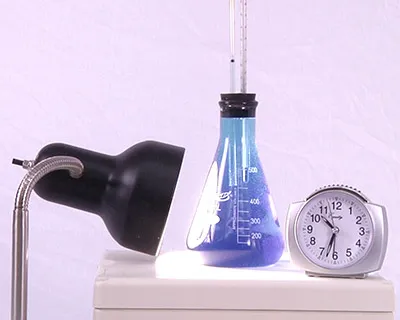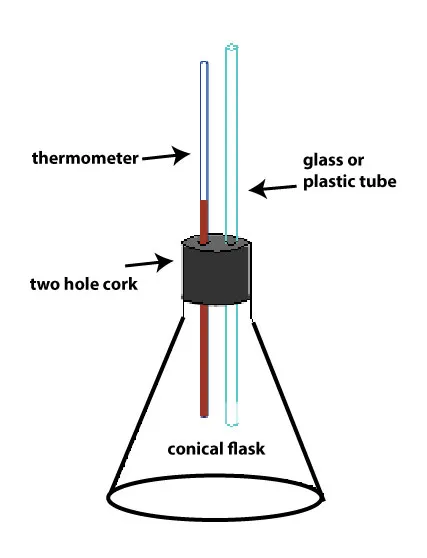Thermal Expansion of Water
Students observe how water expands as it warms. Thermal expansion of seawater is one of the two main causes of rising sea levels that result from a warming climate.
Learning Objectives
- Students will observe the change in volume of water as it is heated.
- Students will be able to describe the relationship between volume and temperature for water (water expands as it warms).
- Students will learn that thermal expansion of seawater is one of the main causes of sea-level rise due to warming climate.
Materials

The setup for thermal expansion demonstration
UCAR
To do this activity as a class demonstration, you will need one of each of the following. To have students make the model themselves, you will need one set for each group.
- Conical flask
- Two-hole cork for flask
- Thin, glass or plastic tube
- Long thermometer
- Portable, clamp-on reflector lamp
- 100 Watt lightbulb
- Food coloring
- Water
- Marker
Directions

Detail of flask setup for the thermal expansion activity
- Completely fill the flask with very cold water (to improve visibility, dye can be added).
- Place the thermometer and glass or plastic tube into the cork.
- Place the cork (with tube and thermometer) into the mouth of the flask. The water should rise a bit up the tube.
- Have a student report the temperature of the water and mark the water level in the glass tube with marker.
- Ask students to make a prediction about what will happen to the water level when exposed to heat.
- Place the flask under the lamp. (Lamp should be aimed towards the water, not the top.)
- Turn on the lamp and within 5-10 minutes the water level in the glass tube will have risen.
- Discuss results, hypotheses, and how this example relates to the effect of climate change on sea level. As with all models used in to describe Earth processes, you may wish to discuss how this model is like, and not like, an ocean basin so that students understand the utility of the model and its limitations.
Background
About Sea Level Rise
Increase in Earth's global temperature is causing an increase in sea level. There are two reasons for this accelerated rise in sea level. First, as Earth warms, the ocean absorbs some of the heat from the atmosphere and as it warms, the seawater expands. A greater volume of ocean water due to thermal expansion causes a rise in sea level. Second, rising temperatures are causing ice and snow on land to melt, thereby increasing the amount of water in the oceans. (Only melting of ice and snow that are on land will increase sea level. The melting of floating ice will not affect sea level.)
Throughout Earth history, there have been periods of glaciation followed by warming trends in which the glaciers retreated towards higher latitudes and higher altitudes. At present, glaciers throughout the world are retreating and the amount of snow and ice at the poles is shrinking. The present interglacial warm period began about 14,000 years ago. At that time sea levels were about 75 to 100 meters lower than they are today. The sea level rose rapidly (up to 1 meter per century) as massive amounts of snow and ice melted. Today the rate of sea-level rise is much lower at 15-17 centimeters per century. However, the rate of sea-level rise is increasing as the rate of global warming increases. An accelerated rate of sea-level rise would inundate coastal wetlands and lowlands, increase the rate of shoreline erosion, cause more coastal flooding, raise water tables, threaten coastal structures, and increase the salinity of rivers, bays, and aquifers.